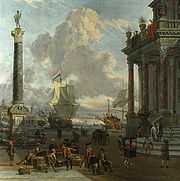Foreign trade of Pakistan
| Part of a series on |
| World trade |
|---|
 |
|
Economic integration |
This article covers topics relating to the foreign trade of Pakistan. For a more general overview, see economy of Pakistan.
Background
Pakistan is a member of the World Trade Organization, and has bilateral and multilateral trade agreements with many nations and international organizations. It is part of the South Asian Free Trade Area agreement and the China – Pakistan Free Trade Agreement.
Fluctuating world demand for its exports, domestic political uncertainty, and the impact of occasional droughts on its agricultural production have all contributed to variability in Pakistan's trade deficit. The trade deficit for the fiscal year 2013/14 is $7.743 billion, Exports is $10.367 billion in (July–November 2013)and imports is $18.110 billion[1]
Pakistan's exports continue to be dominated by cotton textiles and apparel, imports include petroleum and petroleum products, edible oil, chemicals, fertilizer, capital goods, industrial raw materials, and consumer products.
On 12 December 2013, European Union granted GSP Plus status to Pakistan[2] till 2017, which enabled it to export 20% of its good with 0 tariff and 70 percent at preferential rates to EU Market.The status was given after the European Parliament passed the resolution by 406-186 votes.[3]
Exports
Pakistan's exports increased more than 100% from $7.5 billion in 1999 to stand at $18 billion in the financial year 2007-2008.[4][5]
Pakistan exports rice, kinnows, mangoes, furniture, cotton fiber, cement, tiles, marble, textiles, clothing, leather goods, sports goods (renowned for footballs/soccer balls), Cutlery, surgical instruments, electrical appliances, software, carpets, rugs, ice cream, livestock meat, chicken, powdered milk, wheat, seafood (especially shrimp/prawns), vegetables, processed food items, Pakistani-assembled Suzukis (to Afghanistan and other countries), defense equipment (submarines, tanks, radars), salt, onyx, engineering goods, and many other items. Pakistan produces and exports cements to Asia and the Middle East. In August 2007, Pakistan started exporting cement to India to fill in the shortage there caused by the building boom.[6] Russia is a growing market for Pakistani exporters. In 2009/2010 the export target of Pakistan was US $20 billion.[7] As of April 2011,Pakistans exports stand at US $25 billion.
List of trading partners
The following is a list of Pakistan's main trading partners as of 2012.
| Country | Percentage of imports | Percentage of exports | Percentage of total trade |
|---|---|---|---|
| | 19.7 | 11.1 | 16.9 |
| | 10.4 | 18.2 | 13.0 |
| | 12.1 | 8.5 | 10.9 |
| | 12.2 | 8.5 | 9.0 |
| | 3.2 | 13.6 | 6.7 |
| | 6.3 | 0.07 | 4.4 |
| | 3.7 | 2.1 | 3.2 |
| | 3.9 | 0.9 | 2.9 |
| | 3.6 | 1.6 | 2.9 |
| | 3.4 | 1.8 | 2.9 |
| | 0.3 | 7.6 | 2.8 |
| | 4.1 | 0.3 | 2.8 |
References
- ↑ http://in.reuters.com/article/2013/12/13/pakistan-trade-idINL4N0JA23Z20131213
- ↑ Lone, Mahlia S. (30 December 2013). "Pakistan to Benefit From EU Trade Status". WWD. Retrieved 2 January 2014.
- ↑ http://www.business-standard.com/article/news-ani/pak-gets-gsp-plus-status-till-2017-for-free-access-to-eu-market-113121300203_1.html
- ↑
- ↑ "Data: Board of Investment " Economic Pakistan". Economicpakistan.wordpress.com. 2008-02-18. Retrieved 2010-07-29.
- ↑ "Pakistan to start cement export by August end", Yahoo! News, August 3, 2007
- ↑ http://www.freshplaza.com/news_detail.asp?id=66884
External links
| |||||||||||||||||||||||||||||||||||||
| ||||||||||||||||||||||||||||||||||||||||||||||||||||||
| |||||||||||||||||||||||||||||||||||||||||||||||||||||||||||||||||||
